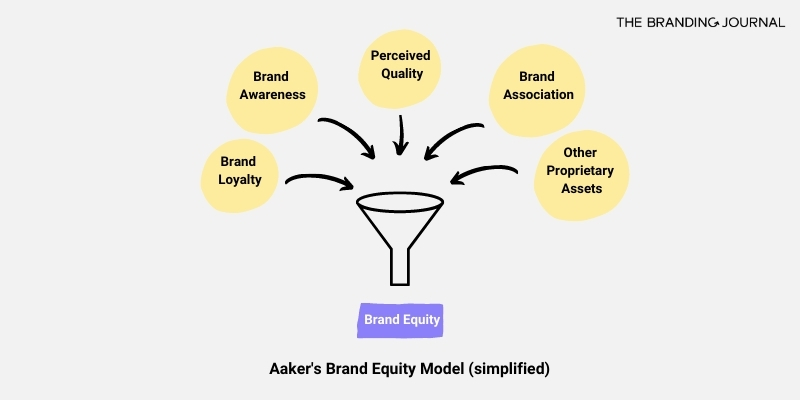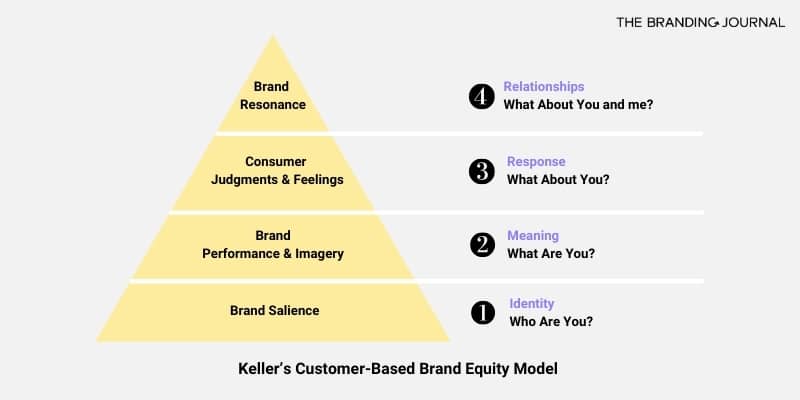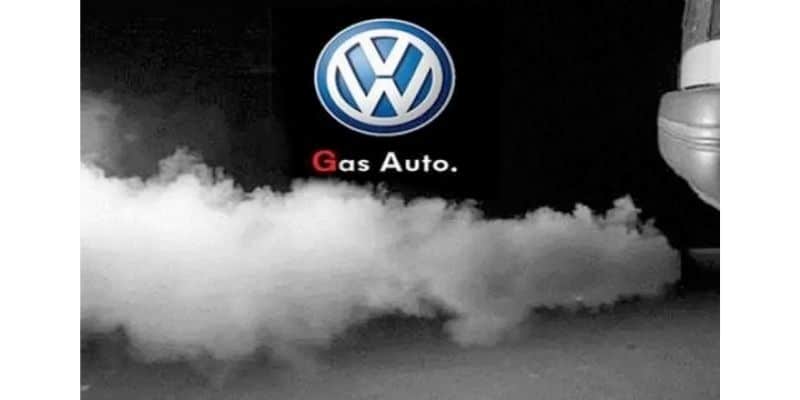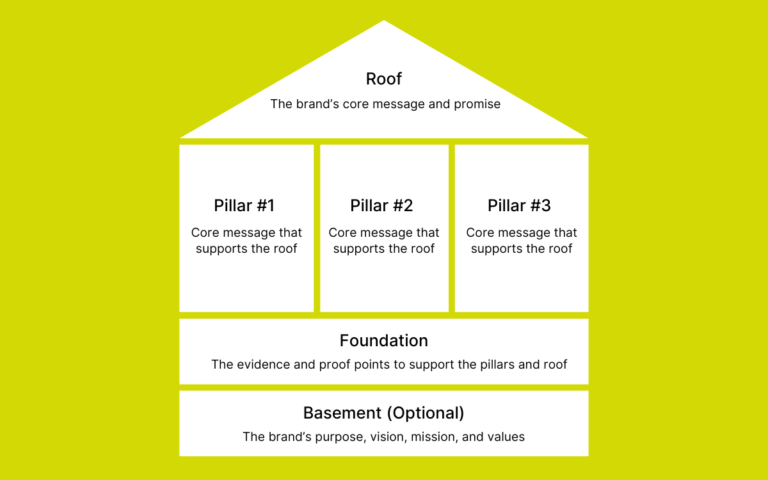In an increasingly competitive marketplace, brands are now more than ever presented with the challenge of capturing and sustaining market share and keeping their customers loyal.
This article will show that one significant way a brand can achieve this is through understanding what is meant by brand equityBrand equity represents the value of a brand. It is the difference between the value of a branded product and the value of that product without that brand name attached to it., and will highlight the importance of building and managing brand equity in the long-term.
Proven Systems for Business Owners, Marketers, and Agencies
→ Our mini-course helps you audit and refine an existing brand in 15 days, just 15 minutes a day.
→ The Ultimate Brand Building System is your step-by-step blueprint to building and scaling powerful brands from scratch.
Table of Contents
Defining Brand Equity
Brand equity is a multi-dimensional and complex concept, but its understanding remains central to a brand fulfilling its competitive potential. Its complexity is demonstrated by a wide range of perceived interpretations and attempted definitions by both academics and professionals.
A popular definition of brand equity is that of renowned marketing theorist and Professor David Aacker, who defines brand equity in his book ‘Managing Brand Equity’ as:
“A set of assets or liabilities in the form of brand visibility, brand associations and customer loyalty that add or subtract from the value of a current or potential product or service driven by the brand.” (Aaker, 1991)
Put simply, brand equity represents the value of a brand. It is the simple difference between the value of a branded product, and the value of that product without that brand name attached to it (Rosenbaum-Elliott, 2015).
Components of Brand Equity: David Aacker’s model
Aacker has derived a simple framework, which features the key components comprising brand equity: brand awareness, brand association, perceived quality, brand loyalty, and other proprietary assets.

Brand Loyalty
Brand loyalty dictates that a consumer who truly believes in the value of a brand’s offerings will often make frequent and repeat purchases from it instead of switching between brands.
High brand loyalty ensures that business is stable and consistent, and enables the organization to capture a larger market share.
Brand Awareness
Brand awareness concerns the extent to which a brand is known or recognizable to a consumer.
A brand with high brand equity will spring to mind when a customer searches for a particular product. This is also termed brand salience; the brand occupies a prominent position in consumers’ minds.
Perceived Quality
This element centers on the brand’s reputation for high-quality products and customer experience.
Good quality is favored more highly than particular product features, with consumers often willing to pay premiums for high-quality products relative to other brands.
Brand Association
Brand association involves anything related to the brand, which evokes positive or negative sentiments, for example, a product’s functional, social or emotional benefits.
More broadly, this relates to the brand’s overall image, and what consumers associate with that image – if consumers associate predominantly positive attributes with the brand, then the brand possesses high brand equity.
Other Proprietary Assets
Proprietary assets include patents, trademarks, and channel or trading partner relationships.
These assets are vital to ensuring that other brands cannot compete by operating under a similar name or using very similar packaging, which may confuse consumers and compete away from a brand’s customer base.
Keller’s Customer-Based Brand Equity Model
Keller, a leading branding author and professor, has comprised a CBBE brand equity model, whereby brand equity addresses four key questions, which relate directly to how a consumer perceives a brand and their requisite attitudes towards it.

Brand Identity: Who are you?
Building strong brand equity requires formulating your brand in a way that causes it to be prominent in the minds of consumers; it’s all about enhancing your brand’s identity and salience.
Brand Meaning: What are you?
How you communicate what your brand stands for will significantly impact your brand equity. It is essential to deliver on both performance (how well your product meets the needs of customers) and imagery (meeting the psychological needs of your customers through developing your brand’s personality and overall image).
Brand Response: What about you?
This concerns how consumers respond to your brand, based on their emotions and perceptions. Brand response is predominantly based upon the brand’s perceived quality and credibility. Therefore, managers should establish a superior level of expertise within their requisite field, communicate clear sets of values, and better fulfill the consumer’s needs relative to competitor brands.
Brand Relationships: What about you and me?
Brand equity can be built by strengthening the connection, or resonance, established between your brand and your customer, evidenced through factors such as repeat purchase or active engagement on social media (both with the brand and those within the brand’s community).
How to Build Brand Equity?

Building strong brand equity is the foundation for an organization’s long-term success. Marketers can reinforce brand equity by actively investing in the components of brand equity.
Some ways you can do this include:
1. Building Brand Awareness
This can be done by creating positive, strong, and unique brand attributes which consumers will retain in their minds, for example, by:
- Advertising your brand on different media
- Engaging with various communities on social media
- Creating viral content (videos, campaigns)
2. Positioning your Brand Consistently within the Market
A brand’s overall culture (including its beliefs, values, and USPs) should remain consistent, such that consumers are not left confused or in doubt about what the brand stands for. This is not to say that managers cannot make tactical strategic changes, such as introducing new packaging or rewriting their slogans, if this is necessary to re-align with changing consumer needs, or external economic and social factors.
Here are some examples:
- A conscious, consistent conveyance of the brand’s core values and meaning
- Relaying to consumers what your products represent, and the core benefits they supply
- Clarifying what your brand is and is not, as compared to the competition
3. Emphasizing Positive Brand Associations
Strong brand associations are crucial to building loyalty towards your brand. Ways of enhancing the way consumers view your brand might include:
- Using innovative and eye-catching means of advertising, highlighting the core functional, social, or emotional benefits of your product
- Ensuring that the business behind the brand is socially responsible and establishes ethical business practices
- Celebrity endorsement
4. Focusing on Building Relationships
It is mainly consumers who determine the strength of your brand’s equity; it is, therefore, essential to build and maintain positive relationships with your target segments. Managers can do this in simple ways such as:
- Staying in touch with customers via social media
- Providing excellent customer service at all times
- Tracking any negative press or feedback, listening and responding
Measuring Brand Equity

Perhaps the most challenging aspect of brand equity is how to calculate it, for there is no unique or consistent metric that brands can use to measure consumers’ subjective emotions and responses.
However, it remains an essential function since losing sight of the strength of your brand equity can impact your bottom line and your ability to compete.
Quantitative measurements
This involves measuring brand equity by looking at financial metrics, which reflect the requisite strength of the brand. Such metrics include:
- Profit margins
- Price sensitivity – known in economics as price elasticity, and concerns the extent to which consumer demand will react to changes in price
- Profitability
- Growth rate
- Market share percentage
- Purchasing frequency
Qualitative Measurements
These measurements cannot measure brand equity as such, but are an essential means of insight. Qualitative methods might include:
- Monitoring social media reactions towards your brand to assess the level of ‘buzz’ your brand creates
- Conducting surveys or focus groups to evaluate consumers’ emotions and feelings towards your brand, indicative of the value of your brand to consumers
- Conducting focus groups to assess consumers’ knowledge of various brands within a market, their favorite brands, and evaluate the relative prominence of your brand within this mix
The Importance of Managing Brand Equity
Managing brand equity over time is essential in achieving several competitive benefits, which will drive profitable growth.
Higher price points
Brands with strong brand equity are in a position to charge premiums, which are not attributable merely to product-related benefits but are attributed to the value and strength of attaching the brand name to that product.
Such products will also enjoy a low price elasticity, meaning that consumers will be less inclined to switch to even those competitors with lower prices.
Product line extensions
Brands with high brand equity are exposed to significantly less risk when introducing line extensions or extending their brand name to new products since the brand name alone carries a value.
If a high brand equity organization such as Apple were to introduce a new line of products, many consumers would likely not hesitate to purchase them. This is due to the positive associations which the Apple brand triggers, and therefore the brand loyalty it inspires.
Increased market share
Brand equity is said to enhance a customer’s ability to interpret and process information. It improves confidence in the purchase decision (Aacker, 1991).
Therefore, an organization with high brand equity can capture and retain a large portion of the requisite market share by acquiring a loyal customer base and better-withstand promotional pressures from competitors.
Brand resilience
Brands need to take a forward-looking approach, recognizing that the added value created by a brand name can act as a security against uncertain market conditions, ever-more-complex consumer demands, shifting behavioral trends, and increasing numbers of competitor market entrants.
Asset for the relationship with other stakeholders
Brands with strong brand equity are often better able to attract talent. Such brands may also be better positioned to gain investors’ trust, who will have greater confidence in yielding returns on their investments.
The same goes for suppliers, who can be more certain of consistent business when entering into contracts.
Brand Equity Examples
Negative Brand Equity: Volkswagen

Failing to adequately manage your brand equity can have negative consequences. The brand name attached to the product harms the business, and the company would be better off producing without their original brand name.
A key example is the Volkswagen emissions scandal of 2015, where it was revealed that the brand had been falsifying their emissions figures using technology, which could cheat on emissions tests. Volkswagen’s brand equity was left subsequently damaged.
The relative perceived quality of Volkswagen contributed highly to this, with consumers undoubtedly feeling as though other mid-market car brands could provide greater overall quality only by fitting their cars with reliable and fully functioning emissions technologies.
Crucially, its brand associations deteriorated since the public could no longer associate the brand with positive feelings of trustworthiness or reliability.
Financial value: using a market share metric, we can see a decline in brand equity given that following the scandal, Volkswagen lost nearly a quarter of its market value (23%), a reduction of approximately $17.6 billion.
Positive Brand Equity: Nike

Source: Business Today
Positive brand equity is demonstrated effectively by the apparel brand Nike.
Nike has successfully built up strong brand awareness using various sponsorships and advertisements at major sporting events, using bright orange shoe boxes, and creating innovative, customer experience-focused stores. Its highly recognizable slogan, “Just Do It”, paired with its infamous ‘swoosh’ logo means that many Nike campaigns do not need to mention the brand name, because brand awareness is already so strong.
When consumers think of Nike, a majority of them are confronted by positive brand associations of innovation, motivation, and determination. These positive associations are created predominantly through their inspiring advertising campaigns and collaborations with influential athletes, such as LeBron James or Michael Jordan, which encourages consumers to believe that Nike is just as expert in the retail field as their representatives are in theirs.
These celebrity endorsements also contribute significantly to the brand’s perceived quality; if Nike is good enough for famed athletes, then it is good enough for us.
This in turn enhances brand loyalty. Consumers feel confident that Nike will deliver consistently high-quality products and customer service. The customer relationship is further enhanced through investment in the customer journey, with collaborative features such as the Nike Run Club, allowing consumers to track their fitness goals and receive top quality coaching, or the ability to personalize sneakers with Nike By You.
Financial value: These branding features add significant extra value to Nike products, making Nike the world’s most valuable apparel brand. In 2020 Nike’s brand value was $39.1 billion, which almost matched its brand revenue of $39.3 billion.
Adidas, its top competitor, comparatively faced a 1% decrease in brand value in 2020, at just $16.5 billion.
Summary
Brand equity represents the value of a brand, and comprises a consumer’s awareness of a brand, the associations they make with the brand, the way they perceive the quality of its products, and the extent to which consumers show loyalty towards it.
Brand equity forms a significant component of marketing strategies, given its significant impact on a brand’s ability to sustain competitive advantage in the long term.
Brands must consistently monitor their brand equity using quantitative or qualitative measures so that their brand strategy can be tailored to strengthen brand equity in line with fluctuating economic trends










